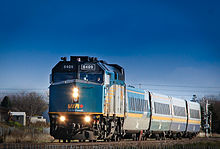Corridor (Via Rail)
As Corridor ( German corridor ) is a group of contiguous railway lines in the Quebec City-Windsor Corridor in the Canadian provinces of Ontario and Quebec indicated that over more than 1000 km between Windsor and Sarnia and Quebec City extend and this among others, six of the ten connect Canada's largest metropolitan areas.
Ownership and operation
The individual routes are owned by different railway companies. Most of it is owned by the Canadian National Railway (CN), with other sections owned by Genesee and Wyoming , Metrolinx and Via Rail . However, they are used exclusively by Via Rail in long-distance passenger rail transport. At the same time, however, many sections of the route are also used for freight transport by their respective owners. Parts of the routes are also used by AMT and GO Transit local trains .
Via Rail operates various intercity connections on the corridor , which make up a large part of the entire Via Rail access offer. However, there is no direct train that connects both ends of the corridor. The longest single connection goes from Montreal via Kingston and Toronto to Aldershot and is served by a pair of trains on working days. The individual connections are also not clocked and only linked to one another with restrictions.
| From | To | Connections on weekdays |
Connections on weekends |
|---|---|---|---|
| Montreal | Quebec | 5 | 3 |
| Ottawa | Quebec | 1 | 0 |
| Ottawa | Montreal | 6th | 4th |
| Kingston | Montreal | 9 | 6th |
| Kingston | Ottawa | 8th | 5 |
| Toronto | Montreal | 9 | 6th |
| Toronto | Ottawa | 8th | 5 |
| Toronto | Kingston | 12 | 9 |
| Niagara Falls | Toronto | 1 | 1 |
| London | Toronto | 7th | 6th |
| Sarnia | Toronto | 1 | 1 |
| Windsor | Toronto | 4th | 1 |
In addition, some Via Rail tourist trains use parts of the corridor. The Canadian uses a short section of the branch between Toronto and Georgetown and the Ocean uses the route between Montreal and Sainte-Foy .
Route
The route is divided into different branches at several points. It begins in Windsor or Sarnia on the border with the United States . The two branches converge in London , but then separate again to run towards Toronto on two routes through the Golden Horseshoe . The northern branch runs on the Goderich-Exeter Railway via Stratford , Kitchener and Guelph . The southern branch runs on a stretch of the CN and also takes the branch from Niagara Falls (also a CN route) at Aldershot near Hamilton . The route between Oakville and Pickering is now owned by Metrolinx . Between Toronto Union Station and Brockville , the combined line runs for long stretches on the former GTR trunk line along the north shore of Lake Ontario before dividing again. A road runs along the Via routes Brockville Subdivision , Smiths Falls Subdivision and Beachburg Subdivision for about 100 km north past federal capital Ottawa , while the other branch more directly on the current St. Lawrence along the old GTR-route to Montreal runs . The Ottawa – East Alburgh railway line (now known as the Alexandria Subdivison ) is partly used between Ottawa and Montreal . From Montreal the route runs via Drummondville through the south of the province of Québec and ends after crossing the Saint Lawrence River again on the Québec Bridge in its capital of the same name .
Most of the routes run on a single track and are not electrified, so that all Via Rail trains are pulled by diesel locomotives.
history
The corridor routes are among the oldest railroad lines in Canada and were previously used by their respective owners for passenger transport. With the takeover of the entire long- distance passenger rail transport by Via Rail, the rail network was restructured and the corridor created. Most of the routes remained the property of the respective freight railways and route rights were leased from Via Rail. However, since this principle affects the reliability of passenger trains, Via Rail began to buy up some routes.
In the 1980s and 1990s, tilting technology was used with the Bombardier LRC trains to increase travel speeds. As this was only moderately successful due to capacity reasons, the locomotives were soon taken out of service. However, with the tilting technology deactivated, the LRC cars are still used today in corridor traffic. In recent years Via Rail has bought additional sections of the route to increase the reliability of the train connections. Since 2015, Via Rail has no longer used Canadian Pacific tracks in the corridor .
economic aspects
More than three quarters of Via Rail's revenues are generated in corridor traffic. Like most rail passenger traffic in North America, however, the passenger revenues in the corridor are not cost-covering and are therefore subsidized by the tax authorities . Compared to the other Via Rail offers, these subsidies are comparatively low.
Web links
Individual evidence
- ↑ http://trn.trains.com/news/news-wire/2015/11/24-via-buys-sub
- ↑ https://www.viarail.ca/en/about-via-rail/media-room/latest-news/99672/23-november-2015-via-rail-expands-its-rail-network-acqui
- ↑ SUMMARY OF THE 2014 - 2018 CORPORATE PLAN AND 2014 OPERATING AND CAPITAL BUDGETS
- ↑ a b Annual Report 2014. (PDF) Via Rail, 2014, p. 9 , accessed on December 22, 2015 (English).


